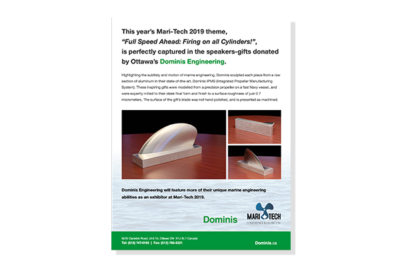Technical Papers
Impact of manufacturing tolerances on propeller performance
Investigation 1: 2D foil section in the rectilinear flow
Ship propellers are typically manufactured to meet the ISO 484 tolerance standards. The majority of propellers manufactured today are manually finishground from castings that have been rough machined on CNC milling machines. Robotic and manual grinding of propeller surfaces introduces inaccuracies and deviations from design, which could lead to degradation of propeller performance in terms of efficiency, cavitation and noise. The leading-edge (LE) is a very challenging area to manufacture accurately yet it has a strong influence on sheet, streak and vortex cavitation. The project compares “as-built” propeller blade sections with their ideal “asdesigned” counterpart to elucidate the effects of manufacturing defects on cavitation and propulsive performance. This study is investigating the effect of sharp-edged flat regions near the LE, which are within the tolerances of ISO 484 class S. The project is organised into three investigations each carried out on progressively more complex configurations starting with a simple 2-dimensional foil geometry and ending with a full propeller rotating geometry.
2D CFD Studies on Effects of Leading-Edge Propeller Manufacturing Defects on Cavitation Performance
In this work, effects of manufacturing defects on the cavitation performance of a propeller blade section were studied with 2-D steady RANS solvers. DTMB modified NACA66 a = 0.8 sections without and with leading edge (LE) defects were investigated at various angles of attack using Star-CCM+ on structured grids. Using the best-practice settings, verification studies were carried out for the cavitation buckets of a 20% thick 2% camber section without a defect. The main body of this work examines minimum pressure coefficients on a 4.16% thick 1.4% camber section with and without defects near the LE. These lead to conclusions about the relative cavitation inception speeds of defective sections and the consequences for manufacturing tolerances.

CNC Machining of Propellers to Better than Class S Tolerances
Producing class S propellers and water jet impellers presents serious challenges for propeller manufacturers. To overcome these challenges and consistently manufacture propellers with superior quality, an integrated approach was adopted when developing and implementing a process for Computer Numerically Controlled (CNC) machining of propeller surfaces. Highlights of this process are: (1) CNC machining of all blade surfaces; extreme surface blending, (2) CNC machining to final form & finish without hand grinding and (3) high precision, better than class S. This paper will describe various challenges encountered in the production of CP propeller blades and how these challenges were overcome in order to produce accurate CP propeller blades which exceed class S tolerances.
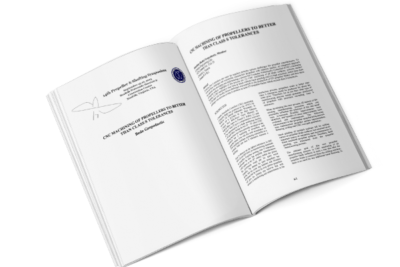
CNC Machining of Monoblock Propellers to Final Form and Finish
This paper describes the innovative way developed by Dominis Engineering Ltd. for CNC machining of monoblock propellers to final form and finish. The foundation of the system is the concept that, in order to preserve accuracy of machined surfaces and eliminate repositioning, monoblock propellers have to be CNC machined in one set-up on a 5-axis milling machine. Using this approach, Dominis has successfully machined to final form and finish a set of high skew 6 bladed monoblock propellers.
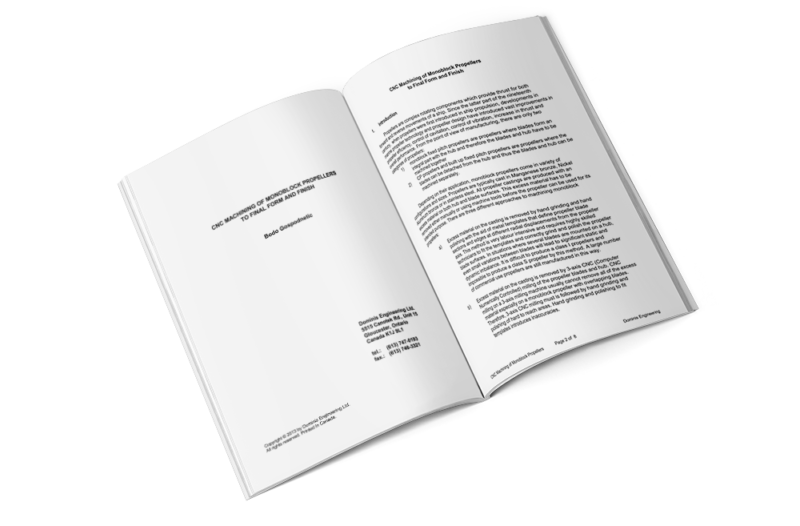
Integrated Propeller Manufacturing System
The paper describes Integrated Propeller Manufacturing System which was developed by Dominis Engineering Ltd. for the purpose of Computer Numerically Controlled (CNC) milling of propellers to final form. The foundation of the system is a propeller geometry data base which contains detailed definition of propeller geometry and all propeller surfaces. Propeller surfaces are defined with high resolution so that the data can be used throughout the entire design/manufacturing cycle of the propeller. Integrated Propeller Manufacturing System allows CNC milling of all propeller surfaces to final form which eliminates need for hand grinding of propellers. The system has been used for CNC milling of propeller models, CNC milling of propeller blade patterns, CNC milling of marine propellers and hydraulic turbine blades, and CNC measurement of propellers and turbines.
CNC Milling of Monoblock Propeller Models
Computer numerically controlled (CNC) milling of monoblock propeller models presents several stimulating challenges for propeller manufacturers. This paper describes the technology for 5-axis CNC milling of monoblock propeller models developed and implemented at Dominis Engineering. The paper concentrates on a description of several key problems associated with 5-axis milling of monoblock propellers and describes procedures, techniques and special tools developed to allow 5-axis milling of monoblock propellers
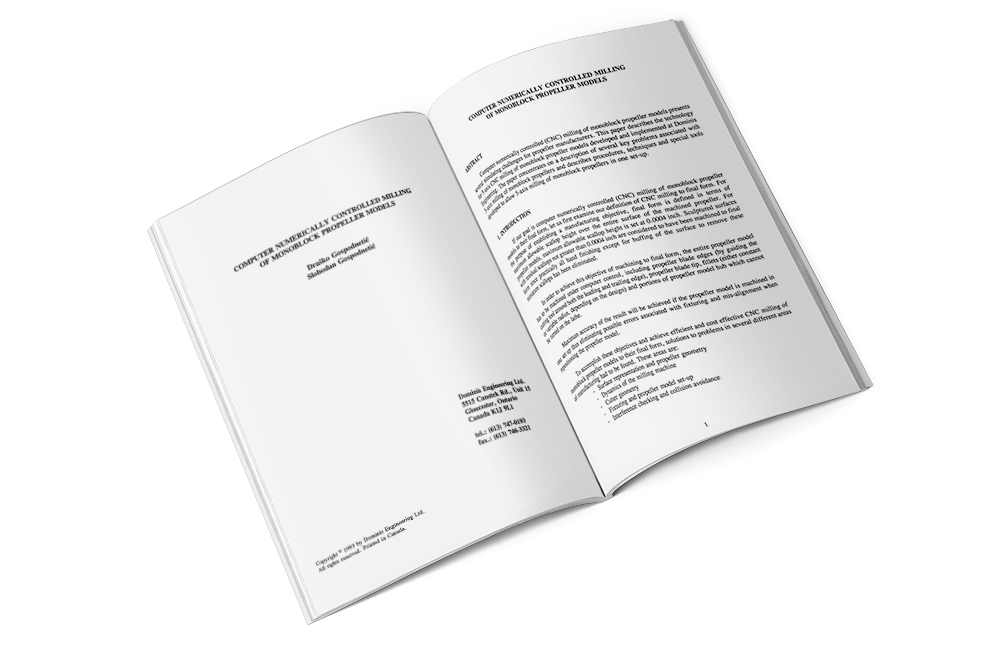
CNC Machining of Ship Model Propellers
Shaping of sculptured surfaces such as propellers has traditionally been the domain of pattern makers and craftsmen. These highly skilled and experienced professionals translate designer’s drawings into three dimensional shapes using templates and very frequently interpret designer’s wishes on the basis of their own experience and skill. This traditional method of rendering propellers is very labour intensive, very time consuming and the results are very dependent on the individual pattern maker’s skills and experience.
This paper describes traditional ship model propeller making, examines the advantages of model propellers milled under computer control and describes technology for Computer Numerically Controlled (CNC) milling of model propellers developed by Dominis Engineering.
Articles and News Releases
Article: Impact of manufacturing tolerances on propeller performance (March 21st 2022)
The behaviour of the 2D foil section in rectilinear flow described in this report is part of the comprehensive investigation under the working title of “Impact of manufacturing tolerances on propeller performance”. The work described in this report was supported by Transport Canada
Article: Croatia’s research may smooth the way for Canadian firm’s quieter propellers – Trade Commissioner (Ma y 20th 2021)
Dominis Engineering Ltd. has long been recognized for the unique way that it designs and makes propellors for large ships, and it has contracts with naval and coast guard authorities in Canada and the United States to show for it.

News release: Dominis has been selected for the 2020 TechConnect Defense Innovation Award
We are proud to announce our selection as a 2020 TechConnect Defense Innovation Awardee. The annual TechConnect Defense Innovation Awards recognizes the top 15% of submitted Challenge technologies as ranked by the Selection Committee.
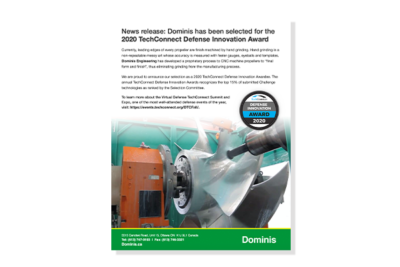
Article: Frigate Propeller Manufacturing in the Nation’s Capital (Spring 2017)
A great many things are made in Ottawa: Legislation, software, propellers… Propellers? Yes. As in frigate propellers. Who would have thought?
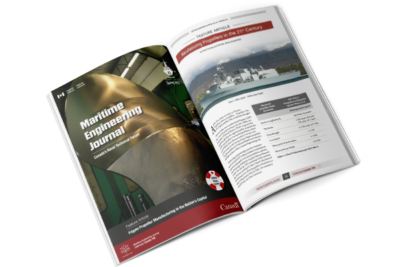
News Release: Dominis Engineering Delivers Fully Machined Water Jet Impellers for Littoral Combat Ship LCS 5 and LCS 7 (August 30, 2013)
Dominis Engineering announced completion and delivery of 2 sets of 4 water jet impellers for Rolls-Royce Naval Marine Inc., in support of U.S. Navy’s LCS program. The impeller is a critical component of a ship’s water jet propulsion system. “The completion of these impellers is an important achievement for Dominis. It demonstrates that we are a leading player in sophisticated Computer Numerically Controlled (CNC) milling of large, complex rotating components” said Bodo Gospodnetic, President, Dominis Engineering. “Impellers and monoblock propellers are strategically important components and we are proud to have developed manufacturing capabilities which are internationally competitive.”
News Release: Dominis Engineering Delivers Water Jet Impellers for a US Navy Program (October 19, 2010)
Dominis Engineering announced completion of a set of water jet impellers for Wärtsilä Defense, Inc., in support of its U.S. Navy program. The impeller is a critical component of a ship’s water jet propulsion system. “The completion of these impellers is an important achievement for Dominis and demonstrates that we are a leading player in sophisticated machining of large and complex components” said Bodo Gospodnetic, President, Dominis Engineering. “Impellers and propellers are strategically important components and we are proud to have developed capabilities which are internationally competitive.”
Article: Small Engineering Firm Sees Growth Ahead (September 6, 2004)
The continuation of a lucrative subcontract with the US Navy could propel a small Ottawa engineering firm to significant expansion…
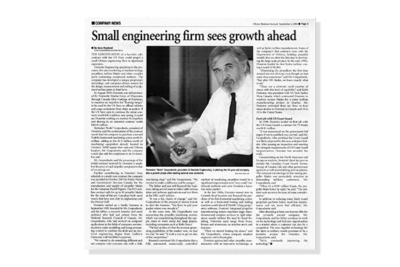
News Release: Dominis Engineering Wins Contract to Manufacture CPF Propeller Blades (October 15, 2003)
Public Works and Government Services Canada (PWGSC) has awarded a multi year contract for manufacturing and supply of propeller blades for the Canadian Patrol Frigates (CPF) to Dominis Engineering Ltd. of Ottawa, Ontario, Canada. The contract calls for the supply of two ship-sets, with an option for the third set, a total of 30 propeller blades…
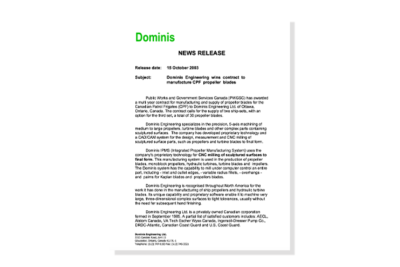
Article: Dominis Engineering makes waves – Canadian Metalworking (July 19th 2021)
Machine shop develops technology to CNC mill high-precision propellers to final form and finish
Article: Low noise ships (in Croatian)
Mitigating the effects of underwater radiated noise has always been important for naval warships. In recent years, it was discovered that URN has a negative effect of sea mammals. Solution can be found in better propellers. 4 December 2020, Lider, Zagreb, Croatia
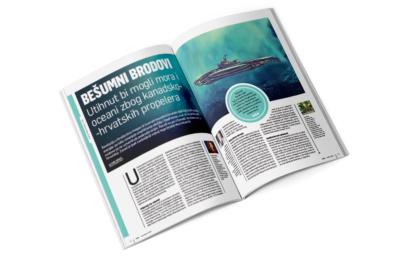
Article: Game Changers (October/November 2016)
Established in 1985, Dominis Engineering specializes in designing, machining and measurement of marine propellers, water jet impellers and hydro turbine runners. The company has developed state-of-the-art technology for CNC milling of sculptured surfaces to nal form and nish which eliminates the need for hand nishing from the manufacturing process.
Article: Raising the Bar (June 2015)
Imagine a casting weighing 1,600 kg arriving in your 9,000 sq ft facility. Then imagine machining that casting on a simultaneous five axis milling machine to create a propeller blade spanning 2.3 m wide by 1.7 m high with surface roughness better than 63 micro in. roughness with surface precision within +/- 0.012 in. several times better than the ISO Class S tolerances required by the Canadian or US Navy. And imagine doing that in one setup on one machine, without the need for hand grinding and hand polishing.
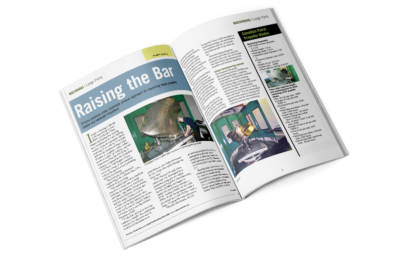
New Release: Dominis Engineering Delivers Monoblock Propellers for a US Navy Program (April 2, 2012)
Dominis Engineering announced completion of a series of monoblock propellers for Wärtsilä Defense, Inc., in support of a U.S. Navy’s program. The propellers are critical components of a ship’s propulsion system. “The completion of these monoblock propellers is an important achievement for Dominis and demonstrates that we are a leading player in sophisticated machining of large and complex components” said Bodo Gospodnetic, President, Dominis Engineering. “Propellers and impellers are strategically important components and we are proud to have developed capabilities which are internationally competitive.”
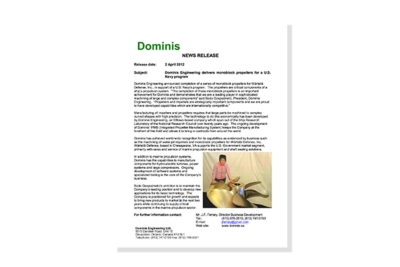
Article: R&D Key to Success in Manufacturing (November 14, 2010)
While many Canadian manufacturers are looking to diversify their customer mix, one Ottawa, ON, manufacturing and engineering firm has done the opposite by carving out a specialty field in propeller and impeller manufacturing.
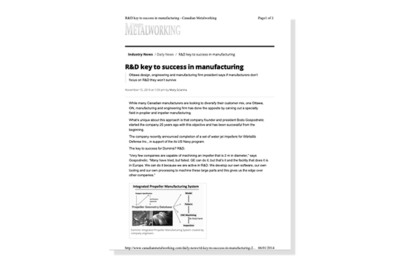
News release: Dominis Has Engineered 45 Extraordinary Gifts for Mari-Tech 2019 Speakers
Inspired by this years theme, “Full Speed Ahead: Firing on all Cylinders!” Dominis Engineering is proud to create beautifully sculpted speakers gifts that powerfully highlight the movement and artistry of marine engineering.
Using their state-of-the-art Dominis IPMS (Integrated Propeller Manufacturing System), Dominis milled each gift from raw aluminum to its sleek final form and finish, with no hand-grinding. These inspiring gifts were expertly machined to a surface roughness of just 0.7 micrometers.
Dominis Engineering will also feature their unique marine engineering abilities as an exhibitor at Mari-Tech 2019.
